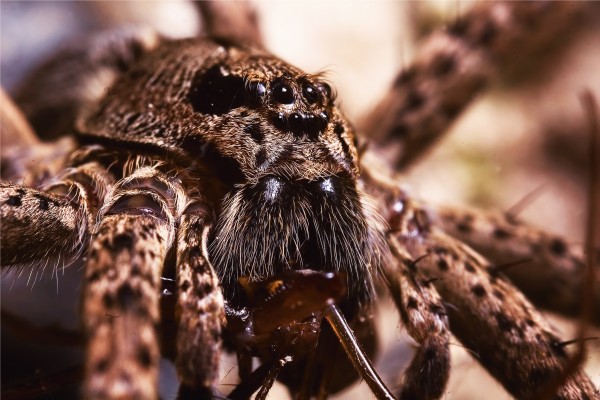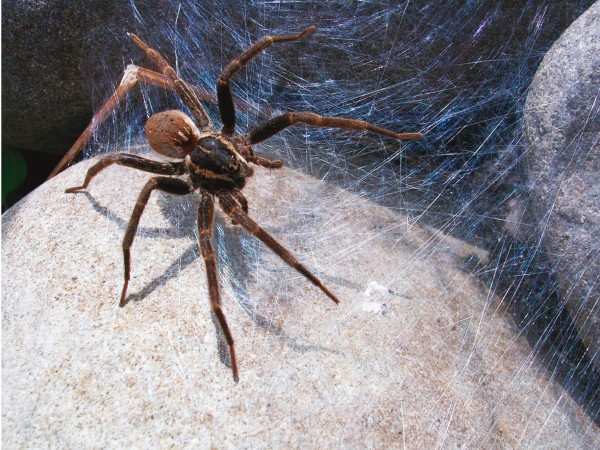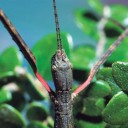
Aquatic assassins
The secret life of fishing spiders

Steam rises off Broken River. Mayflies emerge from their larval stage as winged adults, forming dense clouds, and the water surface boils with feeding trout. Such a sight is the dream of every fisherman, the image that propels them out of bed at 5 am. So it is also for a special type of arachnid, New Zealand’s fishing spiders. They prey on the mayflies, as well as many other aquatic insects, and are well-adapted to take advantage of such an abundant food supply, provided they stay out of reach of the hungry trout.
New Zealand has 1158 described species of spiders, of which some 95 per cent aren’t found anywhere else. The number of species expands to around 2000 when undescribed species are included. However, when it comes to catching prey in a riparian environment, one spider is unmatched. While orb web spiders fabricate large webs, and cursorial spider species live under rocks and logs close to the river’s edge, it is only fishing spiders (Dolomedes spp.) that hunt directly on the water surface rather than having to wait for aquatic insects to appear on land.
Mainland New Zealand has two widespread species of fishing spider which grow up to 7 cm across, including their thickset legs. Dolomedes aquaticus is an open riverbank specialist that lives under rocks, generally within 5 m of unforested rivers. The other mainland species, currently undescribed and known only as Dolomedes III, also live under rocks close to rivers but in forested catchments. Both species have yellow stripes down either side of their head region (cephalothorax) characteristic of endemic Dolomedes species, but are coloured to suit their respective environments—D. aquaticus is a greywacke colour while D. III is painted with a mottled camouflage pattern. The Chatham Islands host a third particularly large species of the Dolomedes genus while on the mainland a fourth species, D. minor, is not dependant on rivers and creates characteristic dense white nursery webs on shrubs. Fishing spiders are relatively common and distinctive, but few people other than keen fishermen will have encountered them.
My first fieldtrip to observe fishing spiders was early in the summer of 2003 with my supervisor Angus McIntosh from Canterbury University. It was dusk when we arrived at the Cass River in the Canterbury high country, just east of Arthur’s Pass. With the light fading we put on our head torches and the hunt for the hunter began. Through the swarm of moths and aquatic insects orbiting my lamp I began to see clusters of light, mere pinpricks low down near the waters edge. As it turned out, D. aquaticus is not that hard to spot at night—reflections from the spiders’ eight eyes give them away almost immediately.

At night they appear in characteristic fishing pose: back legs anchored to a rock on the riverbank with the rest of their body floating on the water surface, front legs outstretched, waiting, listening.
Fishing spiders use the water surface as other spiders use a web, feeling with their feet for vibrations created by potential prey such as aquatic insects. While web-building spiders must distinguish between vibrations caused by trapped insects and those caused by wind or detritus, fishing spiders have to discern signals caused by wind or leaves falling into the river from that caused by prey; all above the background noise created by water swirling around rocks. They achieve this feat of sensory perception using an array of very sensitive vibration receptors, some of which are long hairs (tricho-bothria) on their legs and feet.
Experiments on related species in America showed that blinding a fishing spider had little effect on its ability to find and attack prey, leading scientists to conclude that its sense of touch is more important than vision. In contrast, removing or tampering with the spiders’ vibration sensing organs significantly reduced the spiders’ ability to capture prey, effectively turning them into sitting ducks for potential predators, such as those trout.
But in normal circumstances the fishing spider can detect tiny differences in the frequency of surface wave vibrations and in the number of waves produced. A leaf hitting the water creates a single vibration event, while a struggling insect creates more erratic wave patterns for a longer period. Fishing spiders are also able to determine the distance and angle to the source of vibrations by the subtle differences in amplitude and frequency of the waves created, in the same way that we can locate another person speaking in a crowded room.
Once they have detected the presence of, say, a struggling insect, some fishing spiders take a very direct approach to capturing it, dashing across the water surface and snaring their dinner before it can free itself from the surface tension. Several overseas Dolomedes species even use silk draglines, a bit like a drag-racer’s parachute, to prevent them overshooting their target. D. III, the New Zealand forest fishing spider, has been known to employ such direct tactics.


Further anecdotal evidence of the fishing prowess of these spiders comes from a closely related species in North America, where a gentleman in the 1880s reportedly observed a spider leaping into his pond, dragging his prize goldfish from the water and subsequently devouring it on the bank. D. aquaticus, in general, shows a more sedate approach to capturing prey, often waiting for insects to touch its legs or to fly within range before a rapid lunge ensures that the spider won’t go hungry.
To be able to fish from the water surface these spiders must be able to walk on water. They generally weigh less than a gram and are covered with hydrophobic (literally water-hating) hairs that repel the water and leave the spider dry. However, an interested PhD student might decide to interfere with the laws of physics—the simple addition of a drop of detergent is enough to disrupt the surface tension and the spider sinks instantly, the rules of its world suddenly broken. While water-walking is not unique to fishing spiders, they are the only documented species in New Zealand that use it as part of their hunting repertoire.
The fishing spider’s diet is mainly aquatic insect prey, but it is also an opportunistic feeder that will eat almost anything that comes wriggling its way. On my first fieldtrip I discovered the fun of hand feeding them. I caught a large moth and offered it, struggling in my fingers, to a relatively small juvenile fishing spider. The spider daintily took it, moved itself to dry land and proceeded to eat. I watched this process for almost half an hour; fascinated by the way the spider stood on the tips of its articulated legs and deftly manoeuvred the moth with its mouthparts. She then delicately cleaned all her legs, passing each between her fangs; carefully scraping them clean before wiping each front leg over her eyes. Finally satisfied with her dinner and ablutions she returned to the water’s edge to see what other insects the river would deliver.
Like most New Zealand invertebrates, Dolomedes are nocturnal, feeding between dusk and dawn when most of their avian predators sleep. Lizards, which live in similar rocky habitats, are also likely to prey on the spiders. There have been records of fishing spiders eaten by young dragonflies, moreporks and bitterns. There is even an account of several being fought over by baby goldfinches in the nest.
This species is also vulnerable to a parasitic wasp (family Pompiliidae), that stings the unfortunate spider, paralysing it before dragging it off to its nest so it can lay a single egg in its abdomen. When they hatch, the wasp larvae eat the still-living spider from the inside out. On more than one occasion I have watched as parasitic wasps carried off my field specimens.

But D. aquaticus has developed an effective and dramatic means of escape; pulling themselves through the filmy surface tension, they magically disappear—which isn’t particularly helpful if you are trying to study them. For a while I was perplexed as to how they vanished beneath my poised capturing container, but one night near Porters Pass a large female was waiting at the water’s edge for her dinner to float past when my torchlight startled her. Instead of making for the shore as I expected, she ran under the rock she was fishing from and disappeared underwater. In the light of my torch I could see the silvery outline of air trapped in the hairs on her body. Fishing spiders can remain underwater breathing this air supply through a specialised “booklung” structure on the underside of their abdomen for half an hour. This air layer makes them very buoyant and they must hang onto a rock to remain underwater; if they lose their grip they pop to the surface like a cork, perfectly dry and ready for action. This underwater escape technique is not perfect however. One overseas account reports a parasitic wasp crawling underwater to sting and retrieve a hiding fishing spider, a tremendous effort as the spider is often several times larger than the wasp.
Researchers in New York have documented alternative escape responses of a North American relative called D. triton using an elaborate and bizarre methodology. They freeze-dried frogs, coated them in latex and launched them at unsuspecting fishing spiders, videotaping the jump escape responses. The scientists concluded that the spiders were warned of the frog’s attack by increased air rushing past their vibration sensors and that these escape jumps more than often saved them from becoming a frog’s dinner.
But birds, trout, lizards, parasitic wasps and freeze-dried frogs notwithstanding, Dolomedes can be their own worst enemies. Male fishing spiders have it especially tough as the female is often larger and can choose to overpower and eat him once she has mated. As males can’t detect that a female has mated, some unfortunate victims will be lured in by a hungry female under the false pretence of sex. Scientists suggest that in certain circumstances it can even be beneficial to the males’ offspring for their mother to make a meal of their father. In this way she receives a large feed that will help produce more or larger spiderlings, increasing their survival chances and passing on the dead male’s genes.
Female fishing spiders aren’t the only individuals with cannibalistic tendencies. Spiders eat their own kind, as this results both in a large meal and less competition for shared food resources. Dolomedes just need to be careful that they take on an individual smaller or weaker than themselves as the tables are easily turned with the would-be diner often becoming the dinner. Hunger can increase a spider’s willingness to take a risk, even with larger spiders.
During the course of my PhD I conducted cannibalism experiments with D. aquaticus in the backyard of my flat that involved 16 children’s paddling pools full of spiders at different densities and with different amounts of aquatic insects as food. My flatmates weren’t terribly impressed, but I gathered some interesting data. Spiders that were crowded together were more cannibalistic and food availability had only a minor effect on rates of cannibalism.

One of the last pieces of research I conducted for my thesis highlighted how well-adapted fishing spiders are to their riverine habitat. This can be both a huge advantage and a limitation. Fishing spiders depend on rivers for their food and habitat, and as a water source. But what happens if the river dries? Initially the spiders are likely to benefit from a smorgasbord of insect prey trapped in the shrinking pools. Those insects that can, like several mayfly species, escape by becoming adults, which make easy targets for the fishing spiders aggregating around the drying pools. But the feast doesn’t last long.
On one of my last fieldtrips I was out on a sunny day, so hot that I could almost see the river drying before my eyes; a slender tongue of water gradually retreating upstream. Left behind were the fishing spiders too slow to chase the water front. These animals can survive for a short time without the river, but eventually die either from dehydration or lack of food. I still remember the sad sight of a large female making a dash across the hot rocks trying to reach the retreating water, to no avail.
The fate of the fishing spider is intricately linked to the flow of its natal river. And as long as it contains water, they are one of the best-adapted invertebrates to make use of this food resource and habitat.
















